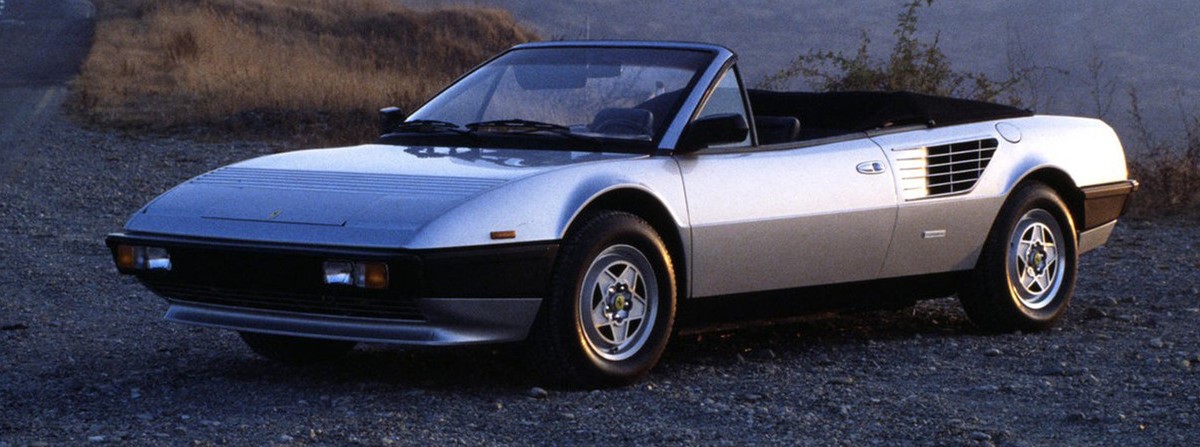
Mondial Cabriolet (1983-1985)
Nine years after its last open-top car (the 365 GTS4) had gone out of production, Ferrari came back with a 2+2 spider. By a bit of canny engineering, Pininfarina managed to give the canvas top the same line as the coupé. In fact, it extended rearwards to include the two buttresses either side of the rear window, and Pininfarina’s clever mechanism allowed the hood to fold away neatly behind the seats.
Despite the absence of a roll-bar, the lack of a roof was compensated for by the strong tubular chassis to which the aluminium body panels were welded, guaranteeing the structural rigidity expected of a car capable of 240 km/h.
A cabriolet version of the Mondial Quattrovalvole was first shown to the press at the Military Academy in Modena in September 1983, at a conference hosted by Enzo Ferrari, the model making its show debut at the Brussels Salon the following January. This model was aimed specifically at the sunny climes of the American west coast, where the early production examples found homes, before European model production commenced in earnest. The manually operated hood of the cabriolet was quite a complex affair, which echoed the profile of the coupé when erected, complete with buttresses to the rear. An aesthetic triumph, but care had to be taken to fold it correctly, or damage could occur.
As with the Mondial Quattrovalvole, the Mondial Cabriolet had the same wedge body shape with the radiator grille beneath the front bumper. Apart from the folding canvas roof, the overall shape was identical to the sister model, including the black plastic wrap around bumpers front and rear, together with the large trapezoidal air intake grilles for the engine bay on the body sides behind the doors, and paired circular rear light assemblies, with Mondial Cabriolet badging to the tail panel. It featured the same extended centre console with the ventilation controls incorporated into it, and the radio forward of the gear change as the coupé. Similarly the door panels and steering wheel were identical to the coupé version. The rear seats of the cabriolet were closer together than on the coupe, to allow for stowage of the hood assembly, and the headrests were omitted. The hood was provided with a matching canvas cover when in the lowered position, with a leather cover available as an option.
The main European market Mondial Cabriolet models had a tubular chassis with factory type reference F 108 BS 100, which featured a bolted rear sub-frame section, so that the complete engine, transmission and rear suspension assembly could be removed as a single unit, for ease of maintenance.
The four valves per cylinder V8 engine of the Mondial Cabriolet was the same design as that used in the Mondial Quattrovalvole model, fitted with Bosch K Jetronic fuel injection and Marelli MED 803A Digiplex electronic ignition to produce a claimed 235bhp for main European market versions, and 230bhp for US market versions. It was of a 90 degree configuration, with belt driven twin overhead camshafts per bank, having a total capacity of 2926cc, with a bore and stroke of 81mm x 71mm, bearing factory type reference F 105 AS 000 for European market cars. The engine was transversely mounted in unit with the all synchromesh five speed transmission assembly, which was below, and to the rear of the engine’s wet sump. The model featured independent suspension via wishbones, coil springs and hydraulic shock absorbers all round, with front and rear anti roll bars.
As with the concurrent 2 seater models both right and left hand drive was available, together with various world market specification models. Mondial Cabriolet models were produced prior to the chassis number 75000, from which point both odd and even numbers were used for chassis numbers, thus all cars in this series carry odd number only chassis numbers. They were produced between 1983 and 1985, during which time 629 examples were produced, in the chassis number range 47247 to 59163.
Specifications and Features
- 629 produced – Mondial Cabriolet
Engine
- Type…………………………….rear, transverse, 90° V8
- Bore/stroke………………….81 x 71 mm
- Unitary displacement……365.86 cc
- Total displacement………..2926.90 cc
- Compression ratio…………9.2 : 1
- Maximum power………….176 kW (240 hp) at 7000 rpm
- Power per litre……………..82 hp/l
- Maximum torque…………260 Nm (26.5 kgm) at 5000 rpm
- Valve actuation…………….twin overhead camshafts per bank, four valves per cylinder
- Fuel feed……………………..Bosch K-Jetronic injection
- Ignition……………………….electronic, single spark plug per cylinder
- Lubrication………………….wet sump
- Clutch………………………..single-plate
Chassis
- Frame…………………………tubular steel
- Front/Rear suspension…independent, unequal-length wishbones, coil springs over telescopic shock absorbers, anti-roll bar
- Brakes………………………..discs
- Transmission………………5-speed + reverse
- Steering……………………..rack-and-pinion
- Fuel tank……………………capacity 87 litres
- Front tyres…………………240/55 VR 390
- Rear tyres…………………..240/55 VR 390
Bodywork
- Type………………………….2+2 cabriolet
- Length………………………..4580 mm
- Width…………………………1790 mm
- Height………………………..1260 mm
- Wheelbase…………………..2650 mm
- Front track………………….1495 mm
- Rear track……………………1517 mm
- Weight……………………….1430 kg (dry)
Performance
- Top speed……………………240 km/h
- Acceleration
0-400 m……………………..14.8 sec
0-1000 m…………………….27.5 sec

You must be logged in to post a comment.